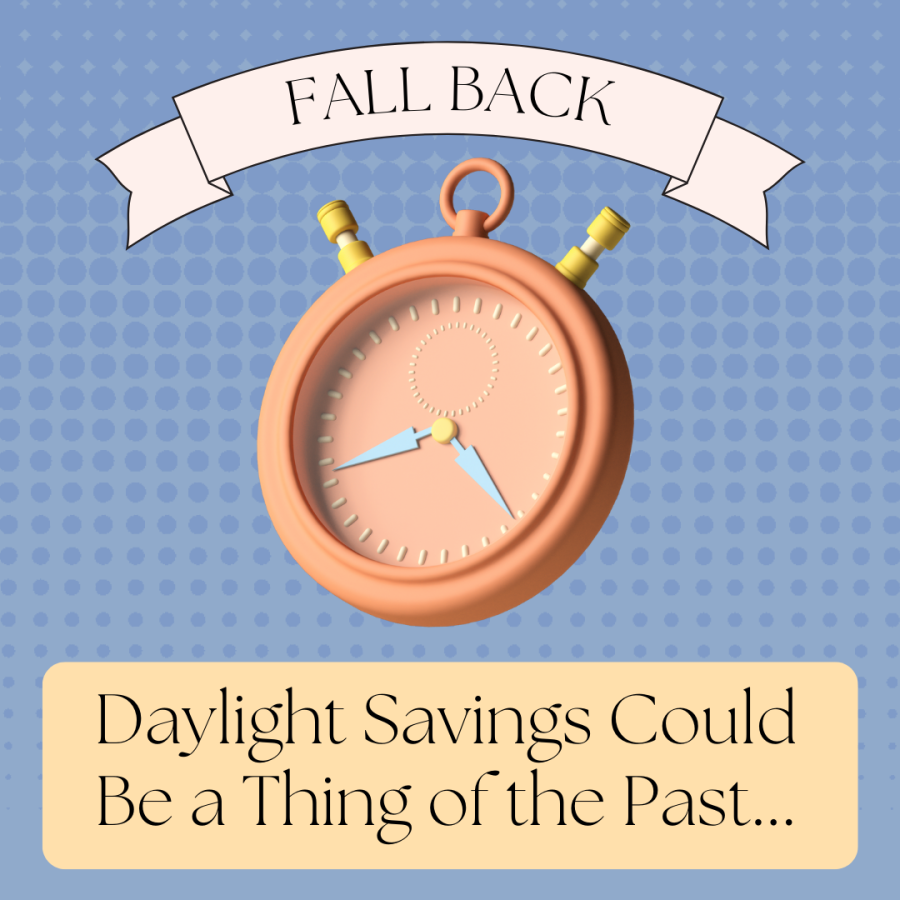Fall Back: Daylight Savings Could Be a Thing of the Past
Does Daylight Savings time really give us more sleep?
November 18, 2022
Many are jumping for joy at gaining an hour of sleep this past Sunday (November 6th), and are unphased by turning all of their clocks back to wake up to sunny skies. It seems we always “fall back” and “spring forward” without ever questioning why we do so, but this most recent Daylight Savings Day is sparking a lot of questions about why we still partake. Sure, it makes sense to adjust times so darkness falls later and sunshine comes earlier, but is there really a point in shifting everything we do by one hour twice a year?
The idea of aligning waking hours to daylight hours through annual time changes was first proposed by Benjamin Franklin in 1784. The Wikipedia page on Daylight Savings Time outlines this: “In a satirical letter to the editor of The Journal of Paris, Franklin suggested that waking up earlier in the summer would economize on candle usage; and calculated considerable savings.” Similar ideas were later proposed in New Zealand and Great Britain, but after some consideration, to little avail. Contrarily, if you fast-forward a couple of centuries in the U. S., you’ll see Daylight Savings Time was formally adopted in 1918. ‘An Act to preserve daylight and provide standard time for the United States‘ was officially enacted on March 19, 1918. The act established standard time zones and set summer Daylight Savings Time to begin on the 31st of March. This was observed for seven months from 1918-1919. After World War I ended, the law was so unpopular that it was repealed in 1919 with a Congressional override of President Wilson’s veto. After this, Daylight Savings Time became a local option and was continued in a few states and cities. DST continued to be reinstated and repealed as the years went on, but today, most U. S. cities and states continue to observe it.
Earlier this year, the Senate passed legislation to make Daylight Savings Time permanent starting in 2023, ending the twice-annual changing of clocks that many know the effects of all too well. The Sunshine Protection Act was passed unanimously by Senators, and it was passed on to the House of Representatives. It “hit a brick wall” in the House, as there were many disagreements over the bill’s language and other fundamentals of its structure. The bill got pushed to the bottom of the House’s list of priorities, according to Rep. Frank Pallone. Pallone goes on to say, “We have so many other priorities, but it doesn’t mean because it’s not a priority that we’re not trying to work on it. We are,” to which he then adds, “If we can accomplish anything, it wouldn’t be until the fall.” Some House members were immediately keen on passing the legislation after it came from the Senate, including Speaker Nancy Pelosi. Although, other representatives, such as Pallone, agreed there were more urgent issues that needed to be addressed. One big conundrum in regards to this bill that the House is facing is what time should be permanent; Daylight Savings or Standard?
Some argue that Daylight Savings Time is more pressing than we (or the House) previously thought. Professor of Neurology and Pediatrics at Vanderbilt, Beth Ann Malow says that “falling back” doesn’t have severe impacts on health, but “springing forward” does. Malow writes, “This is because our clock time is moved an hour later; in other words, it feels like 7 a.m. even though our clocks say it is 8 a.m. So it’s a permanent shift to later morning light for almost eight months – not just for the day of the change or a few weeks afterward. This is particularly notable because morning light is valuable for helping to set the body’s natural rhythms: It wakes us up and improves alertness.” Malow’s point of the necessity of sunlight to our bodies is very important to bring up, as it begs the question of how our circadian rhythms are impacted by Daylight Savings. If we have one 23-hour day and one 25-hour day a year due to DST, our bodily rhythms are not only thrown off for those two days, but for the months following each shift. On the flip side of a lack of sunlight in the morning impeding our alertness, our exposure to sunlight later in the day can delay our brain’s release of melatonin. To this point, Malow continues: “This can interfere with sleep and cause us to sleep less overall, and the effect can last even after most people adjust to losing an hour of sleep at the start of daylight saving time.” From these effects on our bodies and their cycles alone, it’s clear that DST doesn’t come without its drawbacks.
All in all, it’s possible that within the next couple of years, we will no longer be “springing forward” and “falling back”. Depending on how DST legislation fares in Congress and the continuance of negative effects of these time changes coming to light, public opinion will continue to shift away from being in favor of Daylight Savings. While there was reason for the time shifts in the past, nowadays, the costs are clearly outweighing the benefits.







